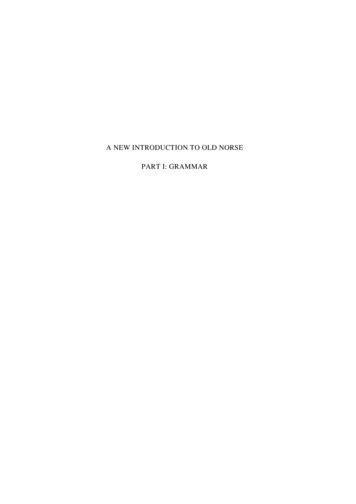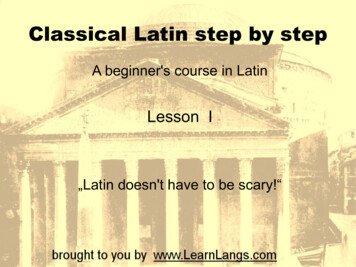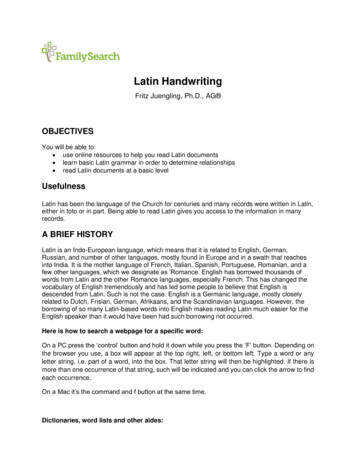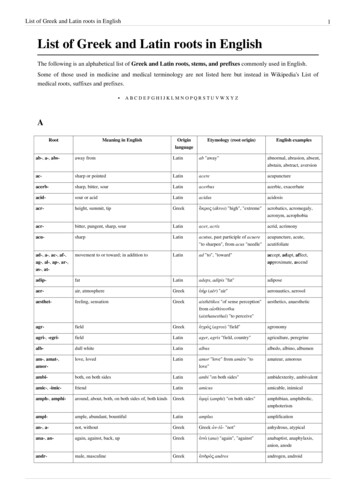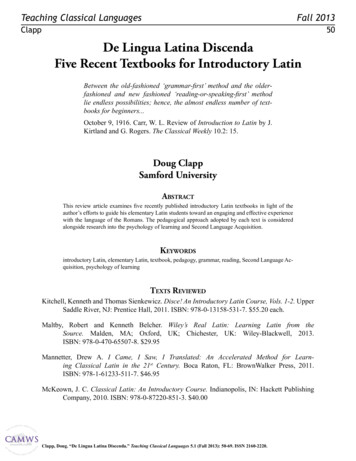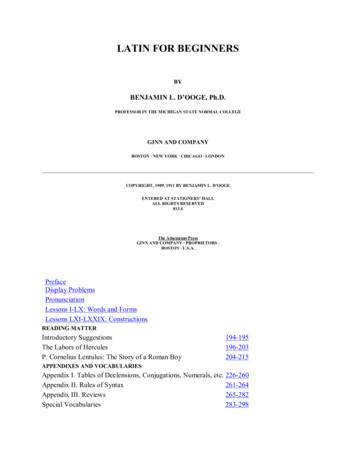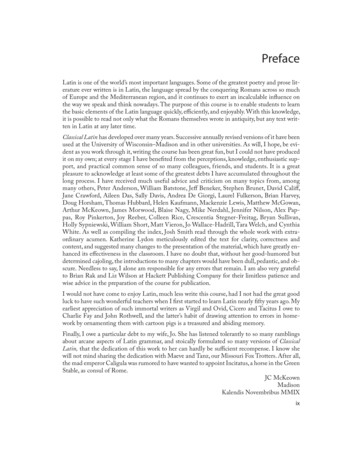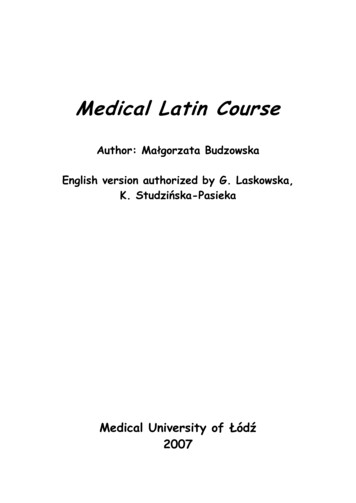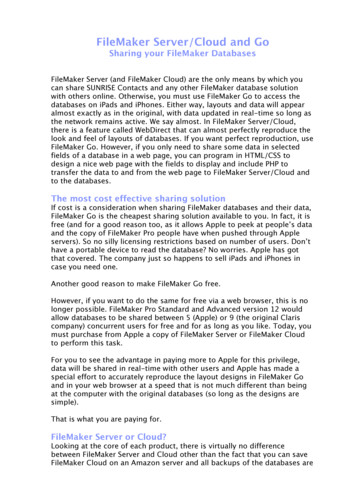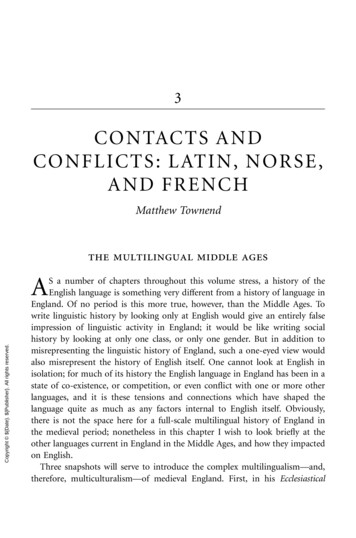
Transcription
3CONTACTS A N DCO NFLIC TS: L ATIN , N OR SE,AND FRENCHMatthew Townendthe multilingual middle agesCopyright {Date}. {Publisher}. All rights reserved.AS a number of chapters throughout this volume stress, a history of theEnglish language is something very diVerent from a history of language inEngland. Of no period is this more true, however, than the Middle Ages. Towrite linguistic history by looking only at English would give an entirely falseimpression of linguistic activity in England; it would be like writing socialhistory by looking at only one class, or only one gender. But in addition tomisrepresenting the linguistic history of England, such a one-eyed view wouldalso misrepresent the history of English itself. One cannot look at English inisolation; for much of its history the English language in England has been in astate of co-existence, or competition, or even conXict with one or more otherlanguages, and it is these tensions and connections which have shaped thelanguage quite as much as any factors internal to English itself. Obviously,there is not the space here for a full-scale multilingual history of England inthe medieval period; nonetheless in this chapter I wish to look brieXy at theother languages current in England in the Middle Ages, and how they impactedon English.Three snapshots will serve to introduce the complex multilingualism—and,therefore, multiculturalism—of medieval England. First, in his Ecclesiastical
62matthew townendHistory of the English People (completed in 731), the Anglo-Saxon monk Bedetalks about the Wve languages of Britain:Haec in praesenti iuxta numerum librorum quibus lex diuina scripta est, quinquegentium linguis unam eandemque summae ueritatis et uerae sublimitatis scientiamscrutatur et conWtetur, Anglorum uidelicet Brettonum Scottorum Pictorum et Latinorum, quae meditatione scripturarum ceteris omnibus est facta communis.Copyright {Date}. {Publisher}. All rights reserved.(‘At the present time, there are Wve languages in Britain, just as the divine law is written inWve books, all devoted to seeking out and setting forth one and the same kind of wisdom,namely the knowledge of sublime truth and of true sublimity. These are the English,British, Irish, Pictish, as well as the Latin languages; through the study of the scriptures,Latin is in general use among them all.’)Bede is talking about Britain here (Britannia), not simply England, but onewould only need to take away Pictish—spoken in northern Scotland—to represent the situation in England, leaving some four languages at any rate. (ByBritish, Bede means what we would call Welsh, and the language of the Scotti iswhat we would now call Irish.)For a second snapshot, let us consider a 946 grant of land by King Eadred (whoreigned 946–55) to his subject Wulfric. The charter is written in a form of Latinverse, and in it Eadred is said to hold the government Angulsaxna cum Norþhymbris / paganorum cum Brettonibus (‘of the Anglo-Saxons with the Northumbrians,and of the pagans with the Britons’), while his predecessor Edmund (who reigned940–46) is described as king Angulsaxna & Norþhymbra / paganorum Brettonumque (‘of the Anglo-Saxons and Northumbrians, of the pagans and the Britons’).In these texts, ‘pagans’ means Scandinavians, and so peoples speaking threediVerent languages are recognized here: the Scandinavians speak Norse, theBritons speak Celtic, and the Anglo-Saxons (of whom the Northumbrians hadcome to form a part) speak Old English. The text itself, being in Latin, adds afourth language.And for a third snapshot we may turn to the monk (and historian) Jocelinof Brakelond’s early thirteenth-century Chronicle of the Abbey of Bury StEdmunds. Jocelin tells us the following about the hero of his work, AbbotSamson:Homo erat eloquens, Gallice et Latine, magis rationi dicendorum quam ornatui uerboruminnitens. Scripturam Anglice scriptam legere nouit elegantissime, et Anglice sermocinare solebat populo, et secundum linguam Norfolchie, ubi natus et nutritus erat,unde et pulpitum iussit Weri in ecclesia et ad utilitatem audiencium et ad decorem5 ecclesie.
contacts and conflicts: latin, norse, and french63(‘He was eloquent both in French and Latin, having regard rather to the sense of what hehad to say than to ornaments of speech. He read English perfectly, and used to preach inEnglish to the people, but in the speech of Norfolk, where he was born and bred, and tothis end he ordered a pulpit to be set up in the church for the beneWt of his hearers and asan ornament to the church.’)Copyright {Date}. {Publisher}. All rights reserved.Here we can observe a trilingual culture exempliWed within a single person.Samson’s native language is English—and a dialectally marked English atthat—and it is English which he uses to preach to the laity; but his eloquencein Latin and French makes him a microcosm of learned and cultured society inthe late twelfth and early thirteenth centuries, where two learned languagestended to take precedence over the majority’s mother tongue.It is no coincidence that all three introductory snapshots are taken from textsin Latin; in the written mode (as opposed to the spoken), it is Latin, and notEnglish, which forms the one constant in the linguistic history of medievalEngland. And it should also be noted how my three snapshots are chronologicallydistributed over the Old English and early Middle English periods—one from theeighth century, one from the tenth, and one from the early thirteenth. It issometimes claimed that post-Conquest England was the most multilingual andmulticultural place to be found anywhere in medieval Europe at any time; but infact there was nothing in, say, 1125 which could not have been matched in 1025 or925, so long as one substitutes the Norse of the Scandinavian settlements for theFrench of the Norman. The Norman Conquest makes no great diVerence interms of the linguistic complexity of medieval England; it merely changes thelanguages involved.the languages of medieval englandThe basic timelines of the non-English languages of medieval England can bestated quickly; a more nuanced account will follow shortly. Celtic (or strictlyspeaking, Brittonic Celtic or British) was, as Chapter 1 has already noted, thelanguage of those peoples who occupied the country before the arrival of theAnglo-Saxons, and is likely to have remained a spoken language in parts ofEngland through much of the Anglo-Saxon period, before it became conWnedto those areas which are (from an Anglocentric perspective) peripheral: Cornwall, Wales, Cumbria, and Scotland. Latin was spoken and read right through themedieval period, beginning with the arrival of the missionaries from Rome in
Parish names ofScandinavian originSouthern limit ofthe DuDanishsettlement 875WeNYPenningtonNorwegiansettlement 901Aldbrough Danishsettlement 876EYYWLaDanishsettlement 879ChDbNtLWatlingS treetCopyright {Date}. {Publisher}. All rights reserved.StRLeNthHuNfCSfBdEssWinchesterFig. 3.1. Scandinavian settlement in Anglo-Saxon EnglandSource: Based on A. H. Smith, English Place-Name Elements, 2 vols. (Cambridge: Cambridge University Press, 1956), Map 10.
Copyright {Date}. {Publisher}. All rights reserved.contacts and conflicts: latin, norse, and french65597. Old Norse was the language of the Scandinavian settlers who entered thecountry in the Viking Age, and settled especially in the north and east of England(see Fig. 3.1). French was the language of the Norman conquerors who arrived in1066, although in time it came to be spoken more widely by the upper and middleclasses. In the study of language contact and the history of English, theselanguages—in particular, Latin, French, and Norse—are what would be termed‘source languages’ or ‘donor languages’. But of course to describe Latin, Norse,and French in such terms, while accurate enough for the study of English, isdeeply misleading, as it leads us to think of them only insofar as they exist tocontribute to English, like satellites revolving round a sun. But to repeat the pointmade in the introduction to this chapter, these languages are just as much a partof the linguistic history of England as English is (and their literatures, as will benoted below, are just as much a part of the literary history of England as literaturein English is).Before proceeding to review these three languages as they existed in England, itis worth saying a few words about Celtic. Celtic appears to have had little impacton English; for this reason it is likely to be the most overlooked language ofmedieval England, and for this reason too it features little in the present chapter.It appears that fewer than a dozen words were borrowed from Celtic into Englishin the Anglo-Saxon period, such as brocc (‘badger’) and torr (‘rock’), even thoughCeltic was widely spoken in Anglo-Saxon England, especially in the early period.The standard explanation for this, which there seems little reason to doubt, isthat since the Britons were the subordinate people in Anglo-Saxon England, theyare likely to have been the ones who learned the language of their conquerors(Old English) and who gave up their own language: it cannot be a coincidencethat the Old English word for ‘Briton’, wealh, also came to mean ‘slave’ (itsurvives in modern English as the Wrst element of walnut, as the surnameWaugh, and, in the plural, as the place-name Wales). However, Celtic wouldassume a much more central place if one were writing a history of language inEngland rather than a history of the English language; the most eloquentmonument to this is the great quantity of place-names in England which are ofCeltic origin, especially river-names (such as Derwent, Ouse, and Lune).In the languages of medieval England it is Latin, alongside English itself, whichis, as has been said, the one constant—a surprising situation for a language whichwas not, after all, ever a mother tongue. Though its use in Anglo-Saxon Englandis normally dated to the Roman mission of 597 (and certainly its unbrokenhistory in England begins at this point), it is, as Chapter 1 has pointed out, alsopossible that the newly settled Anglo-Saxons may have encountered spoken Latin(in addition to Celtic) among the Romano-British peoples whom they conquered
Copyright {Date}. {Publisher}. All rights reserved.66matthew townendin the Wfth and sixth centuries. Nevertheless, leaving aside this one exception, thehistory of Latin in England is of course the history of a primarily writtenlanguage. This is not to say that Latin was not spoken, for it was—endlesslyand exclusively in some environments—but simply that it was always a learnedsecond language. Furthermore, Latin was the language of learning, and for mostof the time this meant that it was the language of the church. Church serviceswere conducted in Latin throughout the Middle Ages; Latin was spoken in themonasteries and minsters; Latin was the language of the Bible. But there wasalmost no one speaking or reading Latin in England who did not also possessEnglish (or sometimes French) as their Wrst language.Old Norse in England could not have been more diVerent. With the exceptionof a handful of inscriptions in the runic alphabet, Norse was never written downin England, only spoken. However, spoken Norse appears to have been bothgeographically widespread and surprisingly long-lived, no doubt because itformed the Wrst language of a substantial immigrant community. Settled Norsespeakers were to be found in England from the 870s onwards, following theViking wars of the time of King Alfred (who reigned over Wessex 871–99) andthe establishment of the so-called Danelaw; that is, the area to the north andeast of the old Roman road known as Watling Street (although the actual term‘Danelaw’ dates from the eleventh century). It is clear that England was settledby both Danes and Norwegians—and perhaps even a few Swedes—althoughas the Scandinavian languages at this point were hardly diVerentiated fromone another it is not much of a misrepresentation to speak of a unitary language, here called Norse (though some other writers employ the term ‘Scandinavian’). Norse continued to be spoken in the north of England certainly into theeleventh century, and quite possibly into the twelfth in some places. In the earlyeleventh century the status of Norse in England received a high-level Wllipthrough the accession of the Danish King Cnut and his sons (who ruled overEngland 1016–42).Finally, we may consider French. As is well known, one of the consequences ofthe Norman Conquest was that the new rulers of the country spoke a diVerentlanguage from their subjects. Originally the Normans had been Scandinavians—the term ‘Norman’ comes from ‘Northman’—who had been granted a territoryin northern France in the early tenth century. These early Normans spoke OldNorse, just like the Scandinavians who settled in England at about the same time.By the early eleventh century, however, the Normans had given up Old Norse andhad adopted the French spoken by their subjects and neighbours; it is an ironythat this formidable people gave up their own language, and adopted that of theirconquered subjects, not once but twice in their history. French, of course,
Copyright {Date}. {Publisher}. All rights reserved.contacts and conflicts: latin, norse, and french67descended from Latin; it was a Romance language, not a Germanic one like OldEnglish and Old Norse. French as it came to be spoken in England is often termedAnglo-Norman, though it should be noted that this designation is based as muchon political factors as it is on linguistic ones.The history of the French or Anglo-Norman language in England falls into anumber of episodes, but at the outset it is important to stress that there is littlevalue in older accounts which depict two distinct speech-communities, Englishand French, running on non-convergent parallel lines for a number of centuries.Nor are direct comparisons between the French and Norse episodes in England’slinguistic history necessarily helpful, as the circumstances were signiWcantlydiVerent: French speakers in England probably formed a considerably smallerpercentage of the population in the eleventh and twelfth centuries than hadNorse speakers in the ninth and tenth, and they were also of a higher socialstatus. In the Wrst decades after 1066, of course, those who spoke French were theNorman invaders, but not many generations were required before the situationhad become very diVerent; parallels with the languages of other immigrantminorities suggest that this is not surprising. From the middle of the twelfthcentury at the latest, most members of the aristocracy were bilingual, and what ismore their mother tongue is likely to have been English; there can have been veryfew, if any, monolingual French speakers by that point. A hundred years later, inthe thirteenth century, one begins to Wnd educational treatises which provideinstruction in French, and it seems from the target audiences of such treatisesthat not only was French having to be learned by the aristocracy, it was alsocoming to be learned by members of the middle classes. One consequence of thisopening-up of French to those outside the aristocracy is that the language beganto be used in increasingly varied contexts. In other words, French became lessrestricted in usage precisely as it ceased to be anyone’s mother tongue in Englandand instead became a generalized language of culture. And the cause of this wasnot the Norman Conquest of England—an event that was by now some twocenturies in the past—but rather the contemporary currency of French as aninternational language outside England. In time, however, the pendulum swungback, and English took over more and more of the functions developed by French(as is explored in the next chapter); by the mid- to late-fourteenth century, the‘triumph of English’ was assured.It should also be stressed that, at diVerent times, there was a thriving literaryculture in England in all three of these languages. Latin and French are the mostobvious. Latin works were composed in England right through the medievalperiod, from beginning to end and then beyond. Bede and Anglo-Saxon hagiographers, for example, were active in the seventh and eighth centuries, Asser, the
Copyright {Date}. {Publisher}. All rights reserved.68matthew townendbiographer of Alfred the Great, in the ninth, Benedictine churchmen like Ælfricin the tenth and eleventh, and Cistercians like Ailred of Rievaulx in the twelfth.Scholastics like Roger Bacon in the thirteenth century and the courtly JohnGower in the fourteenth continued this practice, as did the humanist authorsof the early Renaissance. As for French, Ian Short has pointed out just howremarkable a body of work was produced in England in the twelfth century: theWrst romance in French composed anywhere was produced in England, notFrance, as were the Wrst historical, scientiWc, and scholastic works in French.Even the Song of Roland, a celebrated landmark in medieval French culture,is found Wrst of all in an English manuscript.1 Indeed, it is little exaggeration toclaim that the evolution of French as a written literary language was largely due tothe Norman Conquest; while in the eleventh and twelfth centuries French inEngland may have advanced slowly in its role as ‘a language of record’ (inMichael Clanchy’s phrase),2 it made exceptionally rapid progress as a languageof literature and culture. Even when English was beginning to re-establish itself asa medium for written literature in the thirteenth and fourteenth centuries thecomposition of French works continued unabated, and it is quite possible thatthe earliest poems of GeoVrey Chaucer were in French. The English literatures ofLatin and French are perhaps familiar enough, but there were also times in thehistory of England when literature in Old Norse was composed and enjoyed inEngland, most importantly during the reign of Cnut, king of England, Denmark,and—brieXy—of Norway as well. Oral Norse praise-poetry, of the type known asskaldic verse, was a popular genre at Cnut’s court at Winchester and elsewhere,and Norse poetry in England exerted an inXuence over both English and Latincompositions of the period. For all three of these languages, then, it is not justthat works circulated and were read in England; many original works werecomposed in this country, a testimony to the vitality of England’s multilingualliterary culture, and another reminder of how misleading it is to take a monolingual view of the past.The phenomenon known as language death occurs when no one speaks or usesa language any more, either on account of the death of its users or (less radicallyand more commonly) on account of their shift to using a diVerent language.Reviewing the three main ‘source languages’ in medieval England, one can Wrstsee that, since Latin in England was, as already indicated, not a mother tongue,the notion of language death is not really applicable. The death of the Norse1I. Short, ‘Patrons and Polyglots: French Literature in Twelfth-Century England’, Anglo-NormanStudies 14 (1992), 229.2M. T. Clanchy, From Memory to Written Record: England 1066–1307 (2nd edn.). (Oxford: Blackwell, 1993), 220.
contacts and conflicts: latin, norse, and french69language in England is likely to have occurred in the eleventh century in mostplaces, as that is when the Norse speech community seems to have shifted tousing English. As for French, one could argue that the standard form of languagedeath occurred in the twelfth century, with the demise of French as the mothertongue of the aristocracy; after the twelfth century, French was in much the sameposition as Latin in its status as a learned language, although the constituenciesand functions of the two languages were diVerent (see further, pp. 70–1).Language death is an important phenomenon, not just for the languages andspeech communities involved, but for their neighbours and co-residents. As weshall see in the rest of the chapter, it was in their deaths, just as much as in theirlives, that the non-English languages of medieval England exerted an enormousinXuence on English itself.Copyright {Date}. {Publisher}. All rights reserved.contact situationsThe historical sociolinguist James Milroy insists: ‘Linguistic change is initiated byspeakers, not by languages’. What is traditionally termed ‘language contact’, or‘languages in contact’, is in reality contact between speakers (or users) of diVerentlanguages, and an emphasis on speaker-activity has far-reaching implications forthe writing of linguistic history. As Milroy observes, ‘the histories of languagessuch as English . . . become in this perspective—to a much greater extent thanpreviously—histories of contact between speakers, including speakers of diVerentdialects and languages’.3 This is one reason why the previous section paid dueattention to the non-English speech communities, and to the uses of languagesother than English, that were such a deWning feature of medieval England.Languages do not exist apart from their users, and any study of language contactmust be emphatically social in approach. In this section the actual processes ofcontact will be examined, before moving on to look at their linguistic consequences.The nature of the social contact, together with the conWgurations of the speechcommunities, has a governing eVect on the type of linguistic impact that willoccur. Clearly, contact between languages—or rather, between users of languages—involves bilingualism of some sort. This bilingualism can either beindividual or societal; that is, one may have a society which is at least partlymade up of bilingual speakers, or conversely a bilingual society which is made up3J. Milroy, ‘Internal vs external motivations for linguistic change’, Multilingua 16 (1997), 311, 312.
Copyright {Date}. {Publisher}. All rights reserved.70matthew townendof monolingual speakers. So, for the contact between Norse and English speakersin Viking Age England, it is likely that, at least for pragmatic purposes, speakersof the two languages were mutually intelligible to a suYcient extent to precludethe need for bilingualism on either a major or minor scale (in the form of asociety which was made up of bilingual individuals, or else one which relied on asmall number of skilled interpreters). Viking Age England was thus a bilingualsociety dominantly made up of monolingual speakers of diVerent languages; asan analogy it may be helpful to think of contemporary contact between speakersof diVerent dialects of English.The situation with French was clearly very diVerent, as English and French—being respectively a Germanic language and a Romance one—were so dissimilaras to permit no form of mutual intelligibility. In such circumstances one musttherefore think in terms of individual bilingualism. But of course exactly whothose individuals were, and what form their bilingualism took, changed overtime. Once their early monolingual period had come to an end, initially it was theNorman aristocracy who spoke French as their Wrst language and who learnedEnglish as their second. But soon these linguistic roles had been reversed andFrench, as we have seen, became the learned second language, after which it alsobegan to be learned by those below the level of the aristocracy. However, it isimportant to stress that French speakers in England always formed a minority;the majority of the population were monolingual, and the language they spokewas English.The situation for Latin was diVerent again. All those who knew Latin alsospoke at least one other language, and in the post-Conquest period sometimestwo (French and English). Being the language of books, Latin also introducesanother form of language contact: that between an individual and a written textin a foreign language. One might think of the contact between users and books asa sort of second-order contact—clearly it does not represent the same form ofsocietal bilingualism as that between individuals—but at the same time it isimportant not to overplay this diVerence. In the medieval period even writtentexts had a dominantly oral life: literature was social, texts were read out loud,and private silent reading had barely begun. In any case, Latin was the language ofconversation and debate in many ecclesiastical and scholarly environments: it wasspoken as a learned language in just the same way as French was in the latermedieval period, so one should not dismissively characterize Latin as a ‘dead’language in contradistinction to French, Norse, and English.How do these various circumstances of bilingual contact (whether individualand/or societal) work out in terms of their eVect on English? That is, the questionto be asked is: how exactly do elements from one language come to be transferred
Copyright {Date}. {Publisher}. All rights reserved.contacts and conflicts: latin, norse, and french71into another language, whether those elements are words, sounds, or evensyntactical constructions? As stated above, languages in contact do not existapart from their users, so there must be speciWc, observable means by whichlinguistic transfer occurs. Words do not simply Xoat through the air like pollen;as James Milroy insists, what we are dealing with here is the history of people, notof disembodied languages.In understanding and analysing the processes of linguistic inXuence a crucialdistinction made by modern linguists is that between ‘borrowing’ on the one handand ‘imposition’ or ‘interference’ on the other (and it should be noted that‘borrowing’ has a more precise meaning here than in older treatments of thesubject). This distinction turns on the status of the person or persons who act asthe bridge between languages, and may best be appreciated through modernexamples. Suppose a speaker of British English learns a new word from a speakerof American English, and subsequently uses that American-derived word in theirown speech: that would be an example of borrowing, and the primary agent oftransfer would be a speaker of the recipient language. Suppose, on the other hand,that a bilingual French speaker uses a word or a pronunciation from their mothertongue when speaking English. A new word or pronunciation, derived fromFrench, would thereby be introduced into a passage of spoken English; thatwould be an example of imposition or interference, and the primary agent oftransfer would be a speaker of the source language. Of course, for either of theseprocesses to lead to a change in the English language more broadly, as opposed tosimply in the language of one individual at one time, the word or pronunciationwould have to be generalized, by being adopted and used by other speakers of therecipient language. In considering this process of generalization one can see againhow a study of language contact must really be part of a wider study of socialnetworks.This distinction between borrowing and imposition (as I shall henceforth callit) is also very helpful in understanding the phonological form which is taken bytransferred elements. The linguist Frans van Coetsem, who has elucidated thisdistinction, writes as follows:Of direct relevance here is that language has a constitutional property of stability ; certaincomponents or domains of language are more stable and more resistant to change(e.g. phonology), while other such domains are less stable and less resistant tochange (e.g. vocabulary). Given the nature of this property of stability, a language in contactwith another tends to maintain its more stable domains. Thus, if the recipient languagespeaker is the agent, his natural tendency will be to preserve the more stable domains ofhis language, e.g., his phonology, while accepting vocabulary items from the sourcelanguage. If the source language speaker is the agent, his natural tendency will again be to
72matthew townendpreserve the more stable domains of his language, e.g., his phonology and speciWcally hisarticulatory habits, which means that he will impose them upon the recipient language.4That is to say, a word that is transferred through borrowing is likely to benativized to the recipient language in terms of its phonological shape or pronunciation, whereas a word that is transferred through imposition is likely topreserve the phonology of the source language, and introduce that to therecipient language. We shall meet both of these phenomena in the examplesanalysed below.Lexical transfer—the transfer of words from the source language to therecipient language—is not, of course, the only form of linguistic inXuence thatmay occur when users of two languages come into contact, although it is certainlythe most common. So-called bound morphemes (parts of words like preWxes orsuYxes) may also be transferred, as may individual sounds, or word-orders andsentence structures, or (at the written level) letter forms and spelling conventions. In other words, while its most common form is lexical, linguistic inXuencecan also be morphological, or phonological, or syntactic, or orthographic. All theso-called subsystems of language can be aVected through contact, and in thehistory of English’s contact with other languages in the medieval period, all ofthem were.Copyright {Date}. {Publisher}. All rights reserved.consequences for englishAs we turn to consider the consequences of language contact for the Englishlanguage, it is inevitable that our point of view should become more Anglocentric, and less able to hold all the languages of medieval England within onebalanced, multilingual vision. Nonetheless, a reminder is in order before we goon, that the history of the English language forms only a part of the linguistichistory of England in the medieval period, and in the course of what followsI shall also indicate brieXy some of the ways in which English inXuenced
diVerent languages are recognized here: the Scandinavians speak Norse, the Britons speak Celtic, and the Anglo-Saxons (of whom the Northumbrians had come to form a part) speak Old English. The text itself, being in Latin, adds a fourth language. And for a third
